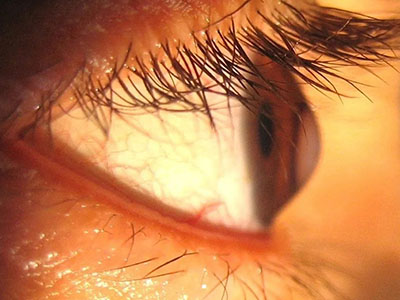KERATOCONUS

What is Keratoconus?
Keratoconus is an eye disorder that occurs when the transparent layer on the outside of our eyes, called the cornea, thins and tapers forward. This disease is progressive and if left untreated, it can lead to visual impairment and even blindness. Keratoconus can occur in one eye or in both eyes.
Causes of Keratoconus
It is not known exactly why keratoconus occurs, but genetic factors are thought to play an important role. That's why it's important for those with keratoconus in the family to have regular eye checks. In addition, having hay fever during childhood and constantly rubbing your eyes can also trigger this disease.
Apart from this, reasons such as improper use of contact lenses, chronic eye irritation, and exposure to ultraviolet rays can also lead to keratoconus.
Who Gets Keratoconus?
According to research, men are more likely to have keratoconus than women. The disease usually begins in adolescence and progresses until the 40s. Keratoconus is not very common; It is seen in 5 people in every 10 thousand.
Symptoms of Keratoconus
Symptoms of keratoconus vary from person to person. But the most common symptoms are:
- Blurred vision (increase in myopia and astigmatism),
- Distorted or distorted vision,
- Light sensitivity and glare in the eyes,
- Eye redness and itching,
- Disturbance in night vision,
- Frequent change of glasses prescription,
- The contact lenses you used to use no longer fit well.
Keratoconus Diagnosis
Keratoconus may be difficult to detect early on. However, if there is someone in the family who has this disease, regular eye examination is important. In detailed eye examinations to make a diagnosis, the thickness and shape of the cornea are examined. Thinning and deformities in the cornea are detected by mapping the eye with a method called corneal topography.
Keratoconus Treatment
The path to be followed in the treatment of keratoconus varies depending on the rate of progression of the disease:
- Stopping the Progression of the Disease: If the thinning and tapering of the cornea increases, a treatment called "Corneal Cross Linking" is applied. This process uses vitamin B2 and ultraviolet light to strengthen the cornea. In this way, the progression of the disease can be stopped and vision loss can be prevented.
- Organizing Vision: If the disease is diagnosed early, glasses may be sufficient. However, in later stages, special contact lenses may be required to provide clear vision. Gas permeable hard lenses or hybrid lenses (hard inner structure, soft outer) can be used.
- Ring Treatment: Ring-shaped hard plastic prostheses are placed into the cornea. This method is applied in cases where the disease has not progressed much. However, the cornea should not be too thin or too steep. This treatment does not completely eliminate visual impairment, but it may help.
- Cornea Transplantation: If other treatments do not work and the disease is too advanced, a corneal transplant is performed. In this operation, damaged corneal tissue is replaced with healthy corneal tissue. The success rate of corneal transplantation is generally quite high.

